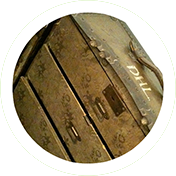Literature’s greatest DIYer has replaced his pen for a trowel…
Lawrence spent the winter of 1923 on the Del Monte Ranch as tenants of the Hawk family. So on his return to the Lobo mountains, he gets in contact with William Hawk for ‘a wagonload[i]’ of timber to begin work on the 160 acre ranch gifted to Frieda by Mabel Dodge Luhan. Mabel is also good for tools and in accessing ‘a sack of fine straw[ii]’ so that he can begin work on plastering a new chimney. Lawrence loves hard graft and signs off his letter to Luhan with ‘been a very busy day – very satisfactory.[iii]’
Mabel Dodge Luhan wants to keep Lawrence happy because she still hopes he will record the lives of the Pueblo Indians, so she sends him some topical reading in the form of The Delight Makers (1890) by the anthropologist and explorer Adolf Bandelier (1840-1914).
Lawrence is in his element at an altitude of 8,600 ft. He’s got four horses, a two-room cabin for Mabel, a one-roomer for Brett and ‘with three Indians and a Mexican carpenter[iv]’ he begins work on a three-room log cabin for him and Frieda. No wonder Geoff Dyer claimed Lawrence was ‘perhaps the first great DIYer in English literature.[v]’
But the graft takes its toll: ‘I don’t write when I slave building the house – my arms feel so heavy, like a navvy’s, though they look as thin as ever.[vi]’ The isolation of cabin life has left him detached from the world. He’s not ‘seen a newspaper for two months[vii]’. He has replaced paper and pen for hammer and trowel and is only interested in disappearing into ‘the big, unbroken spaces round me[viii]’ that are ‘almost Arcadian.[ix]’
What I love about Lawrence is his lack of interest in possessions. He just likes making home. And as he will only be here for the summer, hopes to find someone who might enjoy the fruits of his endeavour when he leaves, ‘so that the place needn’t be abandoned in the winter.[x]’
His writing in May is full of the colours of spring and you can feel him awakening too. He does this by connecting to the natural rhythms of his immediate environment: ‘The sun is setting, the pines are red, the Indians are just started drumming.[xi]’ Not for the first time, he is happiest when ‘right away from the world.[xii]’
To see previous video essays from 1924 see our playlist here. To read from the original source, see The Cambridge Edition of The Letters of D.H. Lawrence, Vol IV 1921 – 24 edited by Warren Roberts, James T. Boulton and Elizabeth Mansfield.
References
[i] Letter to William Hawk, 2 May (L3120)
[ii] Letter to Mabel Dodge Luhan, 12 May (L3123)
[iii] Letter to Mabel Dodge Luhan, 12 May (L3123)
[iv] Letter to Thomas Seltzer, 18 May (L3129)
[v] Geoff Dyer, Out of Sheer Rage (p 141-2)
[vi] Letter to Thomas Seltzer, 18 May (L3129)
[vii] Letter to Catherine Carswell, 18 May 1924 (L3130)
[viii] Letter to Catherine Carswell, 18 May 1924 (L3130)
[ix] Letter to Thomas Seltzer, 18 May (L3129)
[x] Letter to Thomas Seltzer, 18 May (L3129)
[xi] Letter to John Middelton Murry, 16 May (L3125)
[xii] Letter to Thomas Seltzer, 2 May (L3118)
